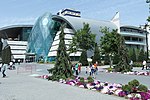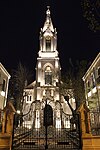Monument to Alexander Pushkin (Baku)
2001 establishmentsAzerbaijan–Russia relationsCultural depictions of Alexander PushkinMonuments and memorials in Baku

The Monument to Alexander Pushkin (Azerbaijani: Aleksandr Puşkinin heykəli) is a monument to the Russian poet Alexander Sergeevich Pushkin in Baku, the capital of Azerbaijan. The monument is located in the park with the same name at the intersection of Pushkin and Uzeyir Hajibeyov streets. The author of the bronze monument is the sculptor, and academician of the Russian Academy of Arts - Yuri Orekhov. This monument is the last work of Orekhov.
Excerpt from the Wikipedia article Monument to Alexander Pushkin (Baku) (License: CC BY-SA 3.0, Authors, Images).Monument to Alexander Pushkin (Baku)
Uzeir Gajibeyov, Baku City
Geographical coordinates (GPS) Address Nearby Places Show on map
Geographical coordinates (GPS)
| Latitude | Longitude |
|---|---|
| N 40.3751 ° | E 49.8548 ° |
Address
Puşkin heykəli
Uzeir Gajibeyov
1010 Baku City (Nasimi Raion)
Baku, Azerbaijan
Open on Google Maps








